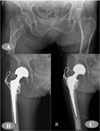Abstract
Objectives
The aim of this study is to evaluate the short-term results and complications of treating the intertrochanteric fracture with bipolar hemiarthroplasty (BHA) in elderly population.
Methods
We retrospectively reviewed 31 unstable intertrochanteric fracture patients who were treated with BHA between January 2007 and August 2009 in older populations more than 65 years old. The 6 males and 25 females had a mean age of 79.8 years (range: 66-88) and a mean follow-up of 36.3 months (range: 24-55). We analyzed the radiological outcomes, functional recovery grade, using Jensen's social function score and Harris hip score (HHS), and complications.
Results
The average operation time and blood loss was 148.9 min (range, 110-215 min) and 455.2 mL (range, 200-1200 mL). Mean preoperative and postoperative hemoglobin (Hb) was 10.9 g/dL (range, 8.6-13.4 g/dL) and 10.5 g/dL (range, 5.1-14.1 g/dL) respectively. Average 1.3 pints of blood transfusion was performed. Ambulation with (or without) crutch was possible at mean 6.8 days postoperatively. The stability and alignment indices were adequate in all cases at final follow-up. On clinical results, the average HHS score, was changed from 79.7 points (range, 44-100) preoperatively to 73.0 points (range, 46-92) postoperatively, and the preoperative and postoperative Jensen's score was 1.8 (range, 1-3) and 2.1 (range, 1-4) respectively.
Figures and Tables
 | Fig. 1(A) Pelvic radiograph showed the unstable intertrochanteric fracture of right femur. (B) On postoperative radiograph, well-fixed and aligned stem and cup was seen. (C) At 28 months postoperatively, radiolucent line of zone 1 was noted between cement and cortex. However, stem stability was maintained. |
References
1. Templeman D, Baumgaertner MR, Leighton RK, Lindsey RW, Moed BR. Reducing complications in the surgical treatment of intertrochanteric fractures. Instr Course Lect. 2005. 54:409–415.
2. Lee JY, Kim SH, Song JH. Surgical treatment with proximal femoral nail for intertrochanteric fracture of the femur in elderly patients. J Korean Hip Soc. 2008. 20:1–6.

3. Gotfried Y. The lateral trochanteric wall: a key element in the reconstruction of unstable peritrochanteric hip fractures. Clin Orthop Relat Res. 2004. 425:82–86.
4. Bridle SH, Patel AD, Bircher M, Calvert PT. Fixation of intertrochanteric fractures of the femur. A randomised prospective comparison of the gamma nail and the dynamic hip screw. J Bone Joint Surg Br. 1991. 73:330–334.

5. Butt MS, Krikler SJ, Nafie S, Ali MS. Comparison of dynamic hip screw and gamma nail: a prospective, randomized, controlled trial. Injury. 1995. 26:615–618.

6. Haidukewych GJ, Israel TA, Berry DJ. Reverse obliquity fractures of the intertrochanteric region of the femur. J Bone Joint Surg Am. 2001. 83:643–650.

7. Im GI, Shin YW, Song YJ. Potentially unstable intertrochanteric fractures. J Orthop Trauma. 2005. 19:5–9.

8. Kim SY, Noh JH. Management of femoral peritrochanteric fracture with proximal femoral nail. J Korean Orthop Assoc. 2006. 41:541–546.

9. Engh CA, Glassman AH, Suthers KE. The case for porous-coated hip implants. The femoral side. Clin Orthop Relat Res. 1990. 261:63–81.
10. Engh CA, Massin P, Suthers KE. Roentgenographic assessment of the biologic fixation of porous-surfaced femoral components. Clin Orthop Relat Res. 1990. 257:107–128.

11. Gruen TA, McNeice GM, Amstutz HC. "Modes of failure" of cemented stem-type femoral components: a radiographic analysis of loosening. Clin Orthop Relat Res. 1979. 141:17–27.
12. Iagulli ND, Mallory TH, Berend KR, Lombardi AV Jr, Russell JH, Adams JB, et al. A simple and accurate method for determining leg length in primary total hip arthroplasty. Am J Orthop. 2006. 35:455–457.
13. Albareda J, Laderiga A, Palanca D, Paniagua L, Seral F. Complications and technical problems with the gamma nail. Int Orthop. 1996. 20:47–50.

14. Kayali C, Agus H, Ozluk S, Sanli C. Treatment for unstable intertrochanteric fractures in elderly patients: internal fixation versus cone hemiarthroplasty. J Orthop Surg (Hong Kong). 2006. 14:240–244.

15. Simmermacher RK, Bosch AM, Van der Werken C. The AO/ASIF-proximal femoral nail (PFN): A new device for the treatment of unstable proximal femoral fractures. Injury. 1999. 30:327–332.

16. Grimsrud C, Monzon RJ, Richman J, Ries MD. Cemented hip arthroplasty with a novel cerclage cable technique for unstable intertrochanteric hip fractures. J Arthroplasty. 2005. 20:337–343.

17. Lee JM, Kim KY. Treatment of unstable trochanteric fracture using sliding hip screw with wiring of lesser trochanter. J Korean Orthop Assoc. 2000. 35:861–866.

18. Nuber S, Schonweiss T, Ruter A. [Stabilisation of unstable trochanteric femoral fractures. Dynamic hip screw (DHS) with trochanteric stabilisation plate vs. proximal femur nail (PFN)]. Unfallchirurg. 2003. 106:39–47.
19. Geiger F, Zimmermann-Stenzel M, Heisel C, Lehner B, Daecke W. Trochanteric fractures in the elderly: the influence of primary hip arthroplasty on 1-year mortality. Arch Orthop Trauma Surg. 2007. 127:959–966.

20. Haidukewych GJ, Berry DJ. Hip arthroplasty for salvage of failed treatment of intertrochanteric hip fractures. J Bone Joint Surg Am. 2003. 85-A:899–904.

21. Green S, Moore T, Proano F. Bipolar prosthetic replacement for the management of unstable intertrochanteric hip fractures in the elderly. Clin Orthop Relat Res. 1987. 224:169–177.

22. Al-yassari G, Langstaff RJ, Jones JW, Al-Lami M. The AO/ASIF proximal femoral nail (PFN) for the treatment of unstable trochanteric femoral fracture. Injury. 2002. 33:395–399.

23. Herrera A, Domingo LJ, Calvo A, Martinez A, Cuenca J. A comparative study of trochanteric fractures treated with the Gamma nail or the proximal femoral nail. Int Orthop. 2002. 26:365–369.





 PDF
PDF ePub
ePub Citation
Citation Print
Print





 XML Download
XML Download